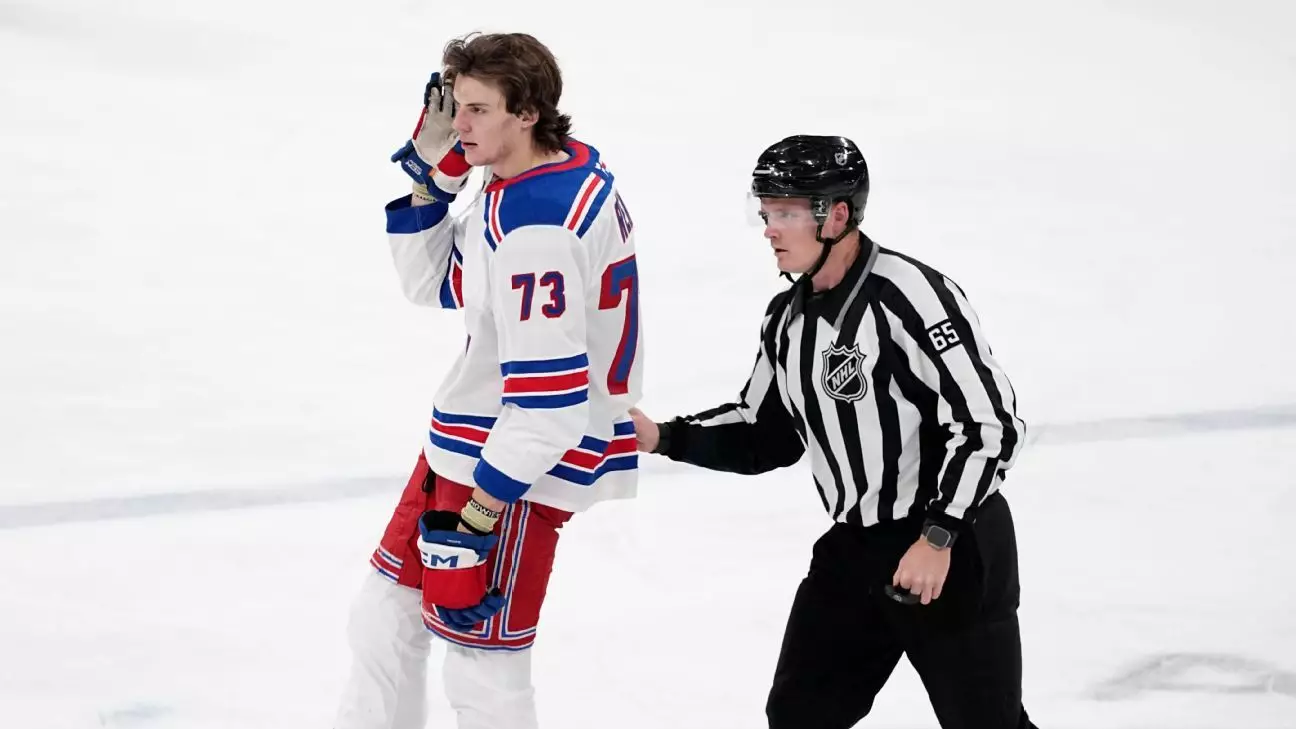In the high-stakes world of professional hockey, the line between aggression and recklessness is often blurred. This was starkly illustrated on Sunday when Matt Rempe, a forward for the New York Rangers, received an eight-game suspension for a hit deemed excessively violent against Miro Heiskanen, a defenseman for the Dallas Stars. The incident occurred during a high-energy match where emotions ran high, and Rempe’s decision to elevate his physicality resulted in significant repercussions not only for himself but also for his team. The National Hockey League’s Department of Player Safety described Rempe’s actions as a violation of multiple critical rules, emphasizing the need for safeguarding players in a sport notorious for its physicality.
Investigating the particulars of the incident reveals a troubling narrative about player responsibility and the consequences of reckless behavior. At the 7:13 mark of the third period in a game that the Rangers ultimately won, Rempe skated towards Heiskanen, who was engaged with the puck and oblivious to the impending threat. Rather than making a tactical choice to avoid conflict, Rempe raised his arm and unleashed a forceful elbow into Heiskanen’s neck, driving him into the boards. This alarming maneuver not only injured the Dallas player but also sparked a melee among players on the ice. Instantaneously, the call for a major penalty and game misconduct was made, signaling that Rempe’s attempt at physical dominance had crossed a dangerous threshold.
The NHL’s decision to suspend Rempe for eight games signals a systemic approach toward punishing repeat offenders. Known as a repeat offender under the collective bargaining agreement, Rempe’s prior suspension—stemming from an elbowing incident involving New Jersey Devils defenseman Jonas Siegenthaler last season—cast a long shadow over his current standing in the league. The NHL’s ruling body noted that players who repeatedly breach rules face heightened penalties, reflecting their commitment to maintaining the integrity and safety of the game. With only 23 games played since his last violation, Rempe’s lack of discipline raises questions about his adaptability and judgment on the ice.
For many professional athletes, suspensions are not merely punitive measures but also financial burdens. With an estimated average yearly salary, Rempe will forfeit approximately $80,000 during his time away from the ice, funds that will be redirected to the Players’ Emergency Assistance Fund. This financial consequence adds yet another layer of complexity to the situation, highlighting how moments of recklessness can affect an athlete’s livelihood. Furthermore, the potential for appeals—both to NHL Commissioner Gary Bettman and a neutral arbitrator—underscores the contentious nature of disciplinary measures in the league.
Rangers coach Peter Laviolette’s commentary on Rempe’s performance prior to the incident reveals the delicate balance between aggression and strategy in hockey. Laviolette acknowledged the impact Rempe has had on the games he’s participated in, expressing a hope that he could channel his physicality without crossing into dangerous territory. With a player as formidable as Rempe, whose presence is as much about intimidation as it is about skill, the challenge lies in maintaining the equilibrium between contributing to the team’s vigor and protecting fellow players. The suspension undoubtedly disrupts the team’s dynamics, as Rempe’s absence from the lineup impacts both their performance and morale.
As the New York Rangers navigate the remainder of their season without Rempe, the incident serves as a crucial lesson in participation responsibility. Aggression in hockey is celebrated but must be coupled with an awareness of safety and sportsmanship. The NHL clearly underscores that while physicality is integral to the sport, it comes with an expectation of accountability. As fans and analysts alike observe how Rempe—and by extension, the Rangers—adapt to these circumstances, one undeniable fact remains: the tension between aggression and responsibility will continue to be a defining trait of professional hockey.

